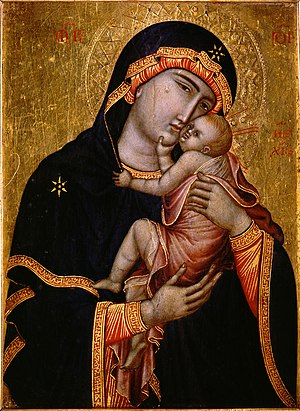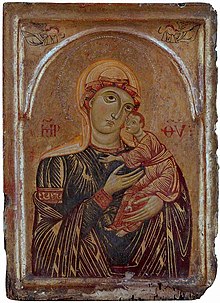Italo-Byzantine

Italo-Byzantine is a style term in art history, mostly used for medieval paintings produced in Italy under heavy influence from
Maniera greca ("Greek style/manner") was the Italian term used at the time, and by
This also covered actual Byzantine icons in Italy; by the Renaissance these were imported on a large scale from Crete, then a Venetian possession. Especially in later periods, the terms also cover paintings done in Italy by Greek or Greek-trained artists; some of these are difficult to distinguish from works of the Cretan School, the main source of Greek imports to Europe.[6] In the mid-20th century, many of these were attributed to Venetian Dalmatia, which is now less popular among scholars.[7]

According to John Steer, "down to the thirteenth century ... all Italian local schools [of painting] were provincial variants of the central Byzantine tradition".[8] Most of the artists of Italo-Byzantine paintings are unknown, though we know some facts about later transitional figures such as Coppo di Marcovaldo in Florence (active mid-13th century),[9] and Berlinghiero of Lucca (active c. 1228–42).[10] The gold ground style encouraged strong outlines in the painted shapes, and "figures are formed out of abstract but expressive shapes designed to identify various body parts or items of clothing while creating beautiful patterns."[11]
Terms and scope

The term "Italo-Byzantine" is used for sculpture much less often, as the Byzantines did not provide large models to follow for that. It may be used of ivories,
The people of the parts of southern Italy and Sicily ruled by the Byzantines during the
Variants of maniera greca in contemporary sources such as inventories included alla greca, more greco, grechescha and pittura greca, as well as ones using "Cretan" or "Candia", the Venetian name for Heraklion, then as now the main city on Crete. These included quadro a la candiota and quadro candiota piccolo ("a small Candia picture"); they are probably best regarded as a characterization by style rather than a record of the place of origin.[16] Especially for Venetian paintings, modern art history may use local terms such as scuola veneto-bizantina ("Venetian-Byzantine school") or "Byzantine (Greco-Venetian) School", especially in Italian.[17]
Baroque sculpture
Maniera greca had a different meaning from the 17th century, when it described a trend in
History

The Italo-Byzantine icon style is usually said to have become common after the
The reasons and forces that led to the development of altarpieces are not generally agreed upon. Placing decorated
In the later part of the 13th century the two leading painters in north Italy, Cimabue in Florence (active c. 1270–1303) and Duccio in Siena (active c. 1268–1311) were both trained and highly skilled in the Italo-Byzantine style, but also developing it in new directions in terms of representing solidity and depth, and loosening up the age-old Byzantine poses. This approach, and its further development by Giotto, was slowly taken up by the main workshops in other cities, but many lesser figures in smaller or more remote cities and towns continued the old style for a considerable time.[25]
The
The maniera greca survived being replaced by the top Italian painters, indeed became more common, as increasing prosperity and cheap Cretan imports spread the possibility of owning an icon for the home down the economic scale. By the 16th century, as revealed by inventories, ownership of alla greca icons was highly common in noble households, and those of the senior clergy, and was spreading to the homes of the middle classes, and later the working classes.[28]

By 1615, one study showed that a remarkable 81% of the households of Venetian labourers possessed artworks of some sort; when icons, these would have mostly have been very small, and perhaps mostly Cretan imports (see below). However, by this period alla greca icons had come to seem old-fashioned, although some lingered until the 18th century.[29] The Cretan icon-industry was already adopting more up to date Western styles, with some success, and the slow loss of Crete to the Ottomans from 1645 to 1669 seriously interrupted supplies.[30]
As the gap in style between contemporary Italian painting and Italo-Byzantine (or Greek
The Greek originals received a late boost in popularity in the decades after the
Western panel-painting before about 1200
Italian painting up to about 1200 was used for
Of the painted versions the
Cretan paintings
Venetian Crete had a busy painting industry, with Cretan, Italian, and (especially after 1453) mainland Greek artists at work. There are examples both of artists from different backgrounds setting up workshops together, and of both Italian and Cretan patrons commissioning works from a painter of a different background.[38]
At least by the late 15th century,[39] Italian importers also used maniera greca (or in forma greca, alla greca) in their contracts to describe one of the two styles of small and cheap devotional paintings by workshops of the Cretan School which were mass-produced in Crete (then ruled by Venice) for export to the West. The alternative style was alla latina ("Latin style"), mostly a conservative Romanesque or Gothic style, where the Greek-style works followed traditional Byzantine style as far as their cheap price allowed.[40]
The Venetian archives preserve considerable documentation on the trade of artistic icons between Venice and Crete, which by the end of the 15th century had become one of mass production. There is documentation of a specific order in 1499, of 700 icons of the
Probably the quality of many such commissioned icons was fairly low, and the dismissive term Madonneri was devised to describe such bulk painters, who later practised in Italy also, often using a quasi-Byzantine style, and apparently often Greek or Dalmatian individuals. Production of icons at these levels seems to have led to a glut in the market, and in the following two decades there is much evidence that the Cretan trade declined significantly, as the European demand had been reduced.[42]
There were also workshops led by masters with a much better reputation, who produced works of much higher quality. El Greco was trained in this part of the Cretan industry, running his own workshop for a few years before he emigrated to Italy in 1567, at the age of about 26. His very individual later Italian style might fairly be characterized as "Italo-Byzantine", though in fact the term is not often used of it.[43]
Notes
- ^ Christiansen
- ^ Drandaki, 41
- ^ Drandaki, 39–41, 48–51
- ^ Drandaki, 39–41
- ^ Voulgaropoulou, 201–203; Omissi, Adrastos, "Byzantium and Italian Renaissance Art"; Vasari, "Life of Giotto": "Là dove venuto, in poco tempo, aiutato dalla natura et ammaestrato da Cimabue, non solo pareggiò il fanciullo la maniera del maestro suo, ma divenne così buono imitatore della natura che sbandì affatto quella goffa maniera greca, e risuscitò la moderna e buona arte della pittura, introducendo il ritrarre bene di naturale le persone vive, il che più di dugento anni non s'era usato; e se pure si era provato qualcuno, come si è detto di sopra, non gli era ciò riuscito molto felicemente né così bene a un pezzo come a Giotto."
- ^ Voulgaropoulou, 212
- ^ Bacci, 78–79
- ^ Steer, 11
- ^ Boskovits et al., 112–125
- ^ Christiansen
- ^ Milk Mac Farland, Joanna, "Florence in the Late Gothic period, an introduction", Khan Academy, accessed 8 April 2021
- ^ Keck, 147–148
- ^ Matthews, Chapter 2, covers these; Boito, Camillo, The Basilica of S. Mark in Venice, 1888, F. Ongania, google books
- OCLC 45958231, google books; Mack instead emphasizes architectural influences from the Islamic world.
- ^ Faris, John D., "The Italo-Byzantine Catholic Church", Catholic Near East Welfare Association
- ^ Voulgaropoulou, 212
- ^ Bacci, 77–78 (with further variants); Art UK, several paintings (late 15th or 16th-century) characterised as "Byzantine (Greco-Venetian) School". These were probably by Greeks living in Venice.
- ^ Lingo, 1–3
- ^ Boskovits et al., 66; Voulgaropoulou, 201–202
- ^ Voulgaropoulou, 201; Virgin and Child, 5; Meagher
- ^ Shrimplin, 2–5; Voulgaropoulou, 230–231
- ISBN 978-0-19-539536-5.
- ^ Virgin and Child, 5
- ^ Steer, 15–22
- ^ Panofsky, 115–120; Meagher
- ^ Evans; Drandaki, 48 (quoted)
- ^ "The Virgin of Tenderness (Copy of 'The Cambrai Madonna') c.1590–1700", Royal Collection
- ^ Voulgaropoulou, 207–210: Drandaki, 48–51
- ^ Voulgaropoulou, 209–210
- ^ Voulgaropoulou, 210
- ^ Voulgaropoulou, 204–208, 231–232; Bacci, 85; Nagel and Wood, 71–72, 106–107
- ^ Nagel and Wood, 107
- ^ Nagel and Wood, 72
- ^ Boskovits et al.,13–15
- ^ Boskovits et al., 13–32 discusses many of these.
- ^ Panofsky, 118
- ^ Bacci, 90–102 discusses some cases.
- ^ Bacci, 75–90
- ^ Bacci, 85
- ^ Drandaki, 43–46
- ^ Maria Constantoudaki-Kitromilides in From Byzantium to El Greco, p. 51-2, Athens 1987, Byzantine Museum of Arts; Nagel and Wood, 107
- ^ Maria Constantoudaki-Kitromilides in From Byzantium to El Greco, p. 51-2, Athens 1987, Byzantine Museum of Arts; Nagel and Wood, 107
- ISBN 9780754668978, 0754668975, google books
References
- Bacci, Michele. "Veneto-Byzantine 'Hybrids': Towards a Reassessment", Studies in Iconography, vol. 35, 2014, pp. 73–106., JSTOR, Accessed 6 Mar. 2021.
- Boskovits, Miklós, Labriola, Ada, & Tartuferi, Angelo, The Origins of Florentine Painting, 1100–1270, Volume 1, 1993, Giunti, google books
- Christiansen, Keith, Madonna and Child, by Berlinghiero, Metropolitan Museum of Art catalogue page, 2011
- Dodwell, C.R.; The Pictorial arts of the West, 800–1200, 1993, Yale UP, ISBN 0300064934
- Drandaki, Anastasia, "A Maniera Greca: content, context and transformation of a term" Studies in Iconography 35, 2014, pp. 39–72, online
- Maryan Wynn Ainsworth)
- Keck, Andrew S. "A Group of Italo-Byzantine Ivories." The Art Bulletin, vol. 12, no. 2, 1930, pp. 147–162, JSTOR. Accessed 3 Mar. 2021.
- Lingo, Estelle Cecile, François Duquesnoy and the Greek Ideal, 2007, Yale University Press, ISBN 9780300124835, google books
- Matthews, Karen Rose, Conflict, Commerce, and an Aesthetic of Appropriation in the Italian Maritime Cities, 1000–1150, 2018, BRILL, google books
- Meagher, Jennifer. "Italian Painting of the Later Middle Ages." In Heilbrunn Timeline of Art History. New York: The Metropolitan Museum of Art, 2000–. online, September 2010
- Nagel, Alexander, and ISBN 9781942130345, google books
- ISBN 0064300269
- Shrimplin, Valerie, Giotto and the Early Italian Resistance, 2021, Online lecture from Gresham College
- ISBN 0500201013
- "Virgin and Child", Italian Renaissance Learning Resources, Oxford Art Online In collaboration with the National Gallery of Art, online
- Voulgaropoulou, Margarita, "From Domestic Devotions to the Church Altar: Venerating Icons in the Late Medieval and Early Modern Adriatic", in Ryan, Salvador (ed), Domestic Devotions in Medieval and Early Modern Europe, 2020, MDPI Books, (reprint from Religions in 2019), online
